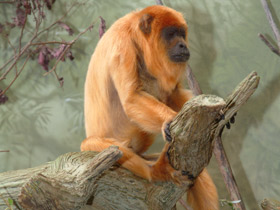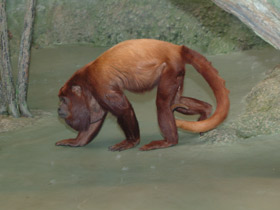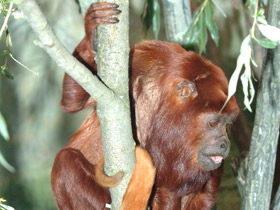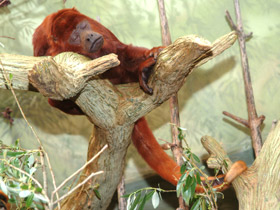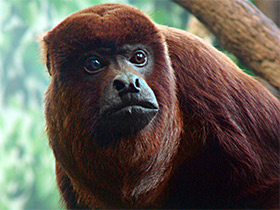The Colombian red howler or Venezuelan red howler (Alouatta seniculus)
The Colombian red howler or Venezuelan red howler (Alouatta seniculus) is a South American species of howler monkey, a type of New World monkey, found in the western Amazon Basin in Venezuela, Colombia, Ecuador, Peru and Brazil. The population in the Santa Cruz Department in Bolivia was split off as a separate species, the Bolivian red howler, in 1986, and more recently, splitting off the population in northeastern South America and Trinidad as the Guyanan red howler has occurred. All howler monkeys belong to the family Atelidae and the infraorder Platyrrhini (New World monkeys).
Distribution and appearance
Alouatta seniculus is a species of platyrrhine primate in the genus Alouatta (howler monkeys).
Alouatta seniculus is the most common of all New World primates. It inhabits the tropical rainforests of northern South America, from Colombia to the Amazon and from Ecuador to central Bolivia.
Alouatta seniculus is the largest of the American monkeys, about the size of a large dog. Males weigh between 6.5 and 8 kg, females are much smaller, weighing between 4.5 and 6.4 kg and have a body length of 46-70 cm, which is shorter than the tail (49-75 cm).
Social interactions
It lives in groups of three to 9 individuals (usually five to seven). The groups are polygynous, with only one or two males and the rest females and their offspring. One male is the usually dominant monkey of the group, the alpha male, and he is responsible for leading them to new food sites and defending them. The females of the group are in charge of the offspring. Venezuelan red howlers are most active in the morning, when the group is on the move to find another feeding spot. These howlers are famous for their "dawn chorus". These roaring and howling calls are performed mostly by the males in the group. The roars can be heard up to 5 km away in the forest, and make their presence known in the area. This is also used to prevent confrontations between groups, which will prevent energy loss by avoiding physical fighting. Because of their low-sugar diets, conservation of energy is key. The calls also help in the scattering of the groups and lessens the competition over food.
Diet and dentition
A. seniculus monkeys are folivores, which means their diets mainly consist of leaves, but they also rely on nuts, small animals, fruits, seeds, and flowers for important nutrients. These foods provide sugar necessary for growth and energy. The most important part of their diets is leaves, which they cannot live without for more than a week. They eat both older and younger leaves; however, the older leaves provide more nutrition. These howler monkeys are able to eat the fibrous leaves due to the structural aspects of their dentition. Narrow incisors aid in the ingestion of the leaves, and molars with sharp, shearing crests help them to better chew their food. In addition, they have complex stomachs to aid in the digestive process. Their hindguts and large intestines also help with digestion. The hindgut contains bacteria that digest leaves and makes up a third of the Venezuelan red howler's total body volume.
Like other New World monkeys, the Venezuelan red howler's dental formula (maxilla and mandible) is two incisors, one canine, three premolars, and three molars.
The lower jaw of Alouatta seniculus is also used for chewing leaves. These monkeys spend most of their lives in the upper level of the rainforest, where they feed on leaves, flowers, various seeds and nuts, as well as fruit.
Reproduction and behaviour
Like other Alouatta species, they breed throughout the year. Pregnancy lasts between 186 and 194 days and one offspring is born, but twins are rare. The newborn calves are totally defenceless and are cared for by their mother, but by the age of one month they are able to cling to branches with their tails. The mother feeds her young with milk for 18 to 24 months.
Females reach sexual maturity at 5 years, males at 7 years. Alouatta seniculus live in family groups of 5 to 15 individuals, of which only one, less often two, are adult males. At puberty, the young males are expelled from the family group and forced to look for a new group.
If an adult male enters a new group, he usually massacres the young present. Mothers fight to protect them, but usually no more than 25% of the calves survive the male's aggression. Newborn calves are always the object of attention from several females, and are often cared for more by females that do not have young.
The most interesting part of the behaviour of these monkeys is the dawn chorus, which can be heard from a distance of 5 km. They are sung by the males, supported by all other members of the herd, and all other Alouatta seniculus within hearing range respond to them. The monkeys use these calls to signal territory occupation and to ascertain the whereabouts of others.
Subspecies
Traditionally, three subspecies of this howler are listed, though Stanyon et al. (1995) concluded the number of chromosomal differences between Alouatta seniculus sara and Alouatta seniculus arctoidea (which resulted in Alouatta seniculus sara being a considered a full species) was on a similar scale to that found between Alouatta seniculus sara and Alouatta seniculus seniculus by Minezawa et al. (1986).
- Colombian red howler, Alouatta seniculus seniculus;
- Ursine howler, Alouatta seniculus arctoidea;
- Juruá red howler, Alouatta seniculus juara.
Alouatta seniculus juara has been described as a different species Alouatta juara.









